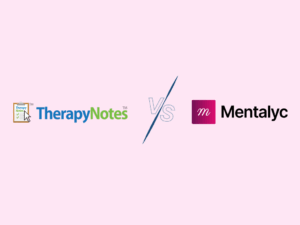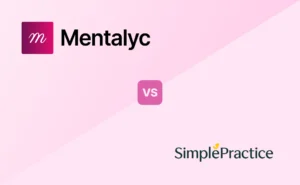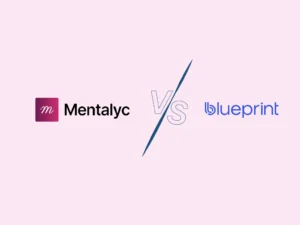Paperwork burnout happens when therapists engage in client documentation to the point of emotional and physical exhaustion. Mental health professionals often face this when writing progress notes. High caseloads and administrative tasks can make it worse. This creates a cycle of stress and burnout that hurts therapists.
This stress affects therapists and the care they provide to clients. Research has linked documentation demands to burnout in mental health therapists. Too much paperwork can increase stress, lower productivity and negatively affect client outcomes.
As a therapist, you’re passionate about helping others but instead of focusing on your clients, you’re drowning in paperwork. You miss family dinners, your days to relax and refresh. With the large pile of progress notes left uncompleted, the burnout feels real.
Why Progress Notes Contribute to Therapist Burnout
Therapists experience paperwork burnout for different reasons. Some reasons include:
- Time Constraints
Balancing client care with progress note-taking can be tough. You want to help people but you also have to compete with admin tasks. Having a large caseload can affect your time management leading to paperwork burnout.
- Complex Documentation Requirements
The types of paperwork required in mental health practice can seem endless. Think progress notes, treatment plans, insurance claims, and compliance forms. Each requires time and detail.
- Lack of Training and Support
Proper training makes a huge difference. Therapists, especially those new to the field, may feel lost or trapped in paperwork. In these times, ongoing support is helpful. You can seek out workshops and mentors that are willing to guide you.
Signs you Might be Experiencing Documentation Fatigue
Documentation fatigue is a real problem that can lead to burnout. Some key signs that you may be experiencing documentation fatigue includes:
- Feeling Overwhelmed by Paperwork
If you’re constantly stressed about keeping up with notes, you might be experiencing documentation fatigue. This feeling can creep in slowly and can lead to increased anxiety and stress levels. It can also lead to procrastination, avoidance, and decreased job satisfaction.
- Compromised Quality of Notes and Treatment
Rushed or incomplete documentation can have negative consequences. It not only impacts record-keeping but also the quality of treatment provided. This can lead to generic notes, incomplete client information, and a reduced focus on treatment planning.
- Impact on Personal Wellbeing
The impact of documentation fatigue extends beyond the workplace. It can easily seep into your personal life, leading to burnout and emotional exhaustion. Documentation fatigue can also lead to difficulty maintaining work-life balance and sleep disturbances.
- Negative Impact on Client Care
When documentation fatigue affects your quality of care, clients suffer. This can lead to spending less time with clients, or impaired empathy and compassion. It could also lead to increased errors during documentation. To resolve these, the focus must remain on clients’ needs.
- Increased Irritability and Cynicism
Paperwork burnout can change your attitude as a therapist. You may not even be aware of it. These changes may include an increased frustration with the system, or a detachment from clients and colleagues. It can also lead to reduced enthusiasm for the profession.
Strategies to Reduce Burnout While Writing Notes
Progress notes are key for good client care. However, therapists often feel stressed by paperwork that comes with it. This can drain their energy for client work and self-care. But documenting everything can be challenging and can lead to burnout. Therapists also need to follow HIPAA and insurance rules. Here are some top strategies to help you reduce paperwork burnout while writing notes:
- Using Mentalyc to Automate Note-Taking
Mentalyc is an AI-powered, automated note-taking and transcription tool. It efortlessly automates progress notes & treatment plans for mental health professionals. Mentalyc records and transcribes therapy sessions, making note-taking easy. It is however important for therapists to ensure that client’s consent is obtained before recording. Mentalyc provides secure recording, saving time, enhancing care, and improving Compliance.
Mentalyc can be customized for different clients and therapy types. It comes in different formats which is useful for mental health providers. So, as a therapist, you can edit and refine the note to suit your personal preference. It provides structured notes from your therapy sessions. This tool aims to save time and effort spent on paperwork. Mentalyc follows HIPAA guidelines by using encryption to protect client data. It is available to all therapists in private practices or group practices.
- Using Templates and Pre-Written Phrases
Templates are helpful for common tasks as they save time and reduce errors. These templates can be used during intake interviews. It could include the following sections:
- Client history
- Current client status
- Client mood
- Mental state of client
- Client’s social functioning
- Client’s physical status
- Client’s diagnosis
- Interventions
- Current medications used by client
- Signed consent for treatment
Therapists could also create progress notes templates for recurring client issues. These can include anxiety, depression, and trauma. It is also important to develop a repository of phrases for treatment plans. This will assist with goals, interventions, and progress assessments. Mentalyc provides the following formatted not templates to make therapist’s work seamless. They include- SOAP notes , DAP notes, PIRP, SIRP, GIRP, BIRP, and PIE.
Here’s an of pre-written phrases highlighted in italics which you can modify to suit your therapy style:
Client Name: Hayes Jacques
Date: [DD/MM/YYYY)
Session Type: Individual Therapy
Presenting Problem: Client reports feeling anxious due to [Specific Trigger]
Goal: “To reduce Client’s anxiety symptoms”
Intervention: “Utilized cognitive restructuring to challenge negative thought patterns related to [Specific Trigger]”. Explored alternative coping mechanisms.
Client Response: “Client was able to identify [Number] negative thoughts and reframe them using more balanced perspectives”. Expressed feeling slightly more in control.
Progress Assessment: “Client reports a decrease in panic attack frequency from [No] times a week to [No] times”
Plan: Continue to practice cognitive restructuring techniques. Introduce mindfulness exercises to manage anxiety.
Setting Boundaries and Realistic Expectations
Time management is key to reducing paperwork burnout. It is important for therapists to allocate time for paperwork. This can include scheduling specific time slots for documentation.
Therapists could employ effective time management techniques like the Pomodoro Technique. This involves working in focused 25-minute intervals. This allows therapists to stick to a schedule that balances rest and documentation.
Staying Organized and Consistent
As a therapist, you’re trained to hold space for others. But if you’re not careful, the admin side of the work can hold you hostage. Staying organized and consistent isn’t just about time management. It’s about mindset, energy, and boundaries. Here are some strategies to stay organized and consistent, so paperwork doesn’t become the part of your job you dread most:
- Create a Workflow That Works for You- Rather than seeing documentation as “extra,” think of it as part of the therapy process. Give it the same care you give to clients. You can use a repeatable note structure like SOAP, DAP, or BIRP to make the documentation process easier. Use templates for intake forms, treatment plans, and progress notes. Most importantly, block your admin hours into your calendar just like your therapy sessions.
- Timebox Documentation- Give yourself a time limit per note like 10–15 mins. You can try to document immediately after the session when your memory is the freshest. You can also consider tools like speech-to-text if you speak faster rather than typing.
- Align Your Routine with Your Natural Energy- Not everyone can do paperwork in the evening, in the morning or between sessions. Think about it. What time of day do you focus best? That’s your sweet spot. Use it for your most brain-heavy tasks like your treatment plans or complex notes. Organize your time around your energy, not just your calendar. This can make a huge difference.
- Batch Create and Automate- Look out for the similar tasks you do regularly and batch them such as all billing, scheduling, or emails at once. There are several practice management systems that can help you with reminders, billing, and documentation. This will enable you to focus more effectively on your clients during therapy sessions.
- Weekly Check-Ins with Yourself- This is a good time to find your least busy day to review your outstanding notes. It is a time to find out what’s working or what’s draining you. Then, adjust your pace accordingly.
- Set Boundaries Around Your Work- Many therapists feel behind. Others feel overwhelmed. But, some don’t talk about it. If you are already experiencing documentation fatigue, reach out to your network of mental health professionals. Learn how others are handling the same things better. You don’t have to figure it out in isolation. You don’t take documentation into your evenings or relaxation days unless absolutely necessary. Work-life balance is important. Moreso, you have to learn to effectively transition from work mode to rest mode.
When to Seek Support: Supervision or Administrative Help
Mental health professionals should always recognize when to seek support. This can involve discussing cases in peer supervision groups that offer insight. This can help them connect with other professionals.
It is also crucial to delegate tasks to administrative staff. This can involve outsourcing billing, or getting a virtual assistant, if you’re in private practice. The end-goal is to free up your time and reduce burnout.
Conclusion
This guide above ensures that progress note-taking is efficient. It is possible to reduce paperwork burnout. Your goal is to aim for clear, ethical, and timely notes. But, being consistent doesn’t mean being perfect. It means finding a rhythm that respects your limits, your brain, and gives you peace. This involves using standardized assessment templates, optimizing billing and using digital tools like Mentalyc. These allow mental health professionals to reclaim significant portions of their time. The use of these approaches can also lead to a greater focus on client care.
FAQs
What Are The First Steps I Can Take To Reduce Progress Note Burnout?
Start by auditing your current note-taking process. Identify the biggest time-wasters and evaluate your documentation style. It is possible that your notes contain too many details or that they are not organized. Also, focus on creating simpler templates. You can do this by adopting a structured note format.
How Can I Convince My Organization To Adopt More Efficient Progress Note Templates?
Efficient progress note templates bring many benefits. These benefits include reduced costs, improved accuracy, and happier staff. Present a clear and strong case. Show how templates can save time and improve accuracy. Highlight the benefits for both clinicians and clients.
What EHR Features Are Most Helpful For Streamlining Progress Notes?
Look into voice-to-text, auto-population, and system integration. Customizable templates, mobile access, and reminders are also valuable features. They reduce manual work and save time.
How Do I Balance Detailed Notes With The Need For Efficiency?
Focus on key details that impact patient care. Use standardized assessment tools and brief, focused progress note formats.
Why other mental health professionals love Mentalyc

“A lot of my clients love the functionality where I can send them a summary of what we addressed during the session, and they find it very helpful and enlightening.”
Therapist

“By the end of the day, usually by the end of the session, I have my documentation done. I have a thorough, comprehensive note … It’s just saving me hours every week.”
CDCII

“It’s so quick and easy to do notes now … I used to stay late two hours to finish my notes. Now it’s a breeze.”
Licensed Professional Counselor

“Having Mentalyc take away some of the work from me has allowed me to be more present when I’m in session with clients … it took a lot of pressure off.”
LPC







